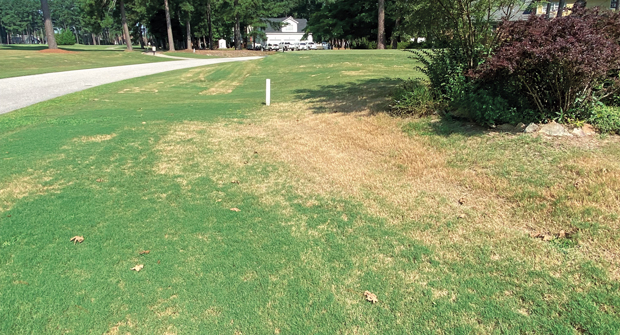
An off-color appearance is an initial symptom of a fall armyworm infestation that may evolve into full-fledged brown patches as these voracious eaters destroy leaf tissue and devastate turf. In fact, there are accounts of armyworm hordes destroying a lawn in a matter of a day.
Armyworms, which are actually moth larvae belonging to the Noctuidae family, are a little trickier to predict than other turf pests. Turf researchers are uncertain what prompts a surge in populations, but one belief is that springs and summers marked with high precipitation rates create environments that armyworms thrive in.
To sell or not to sell?
A preventive anti-grub program is the best way to keep these invaders from gaining a foothold in a residential or commercial turf environment. However, a conundrum for lawn care operators is whether to sell clients preventive applications when they’re uncertain if armyworms will be a problem or wait until symptoms appear and hope clients reach out early enough for treatment.
Therefore, vigilance and knowledge are some of the best tools.
“Generally, I try to keep my clients informed and educated about everything that I’m seeing (firsthand), or I’m hearing from (other LCOs) who are beginning to see problems,” says Patrick Beaman, owner/operator of Grassmasters, a Wilson, N.C.-based lawn care company with a client portfolio that is 90 percent residential and 10 percent commercial. Beaman says he maintains an open line of communication with industry colleagues in Georgia to help gauge the start of the larval activity in his region.
So, as late August and September near — when fall armyworms typically begin to appear — and subtle signs begin to emerge, Beaman will recommend a preventive application of Acelepryn to clients. Acelepryn is an insecticide with the active ingredient chlorantraniliprole. And, since he’s in the transition zone, the application serves as a preventive treatment for his clients with cool-season fescue lawns, not only for armyworms but also Japanese beetles, other leaf-feeding caterpillars and fall webworms.
Clients with warm-season Bermudagrass turf don’t always experience the same degree of fall armyworm infestation, which poses a challenge for lawn care operators.
“When armyworms start to show (in Bermuda turf), clients may look out at their property and see a patch along a tree line that’s beginning to brown and mistake it for drought stress, which looks similar to initial fall armyworm activity,” Beaman says. “So, they crank up the water a bit, thinking it’s a dry patch. So, they run the irrigation for a week or two, creating a bigger problem.”
Part of a comprehensive program
As a preventive measure, Jim Beveridge folds fall armyworm protection into a general anti-grub program involving an Acelepryn application, which has generated positive results.
“In the Greater Cleveland market, everyone wants a comprehensive grub control program,” says the owner of Yards Done Right, a lawn care company based in Westlake, Ohio, primarily serving residential clients. “Acelepryn is pretty versatile, and it’s very effective against fall armyworms and several other grubs, and it has performed really well for us.”
Working with turf researchers at Ohio State University, Beveridge makes his Acelepryn application as early as April and retains solid residual coverage into fall armyworm season.
“We had a pretty serious (fall armyworm) outbreak two years ago,” he says. “My clients didn’t have any issues, but I received calls from competitors’ clients who hadn’t had the preventive application, and their lawns, in some cases, were decimated overnight.”
Beveridge says a curative approach involves a treatment of bifenthrin to get the problem under control. While the damage may seem catastrophic, the turf will grow back over time.

